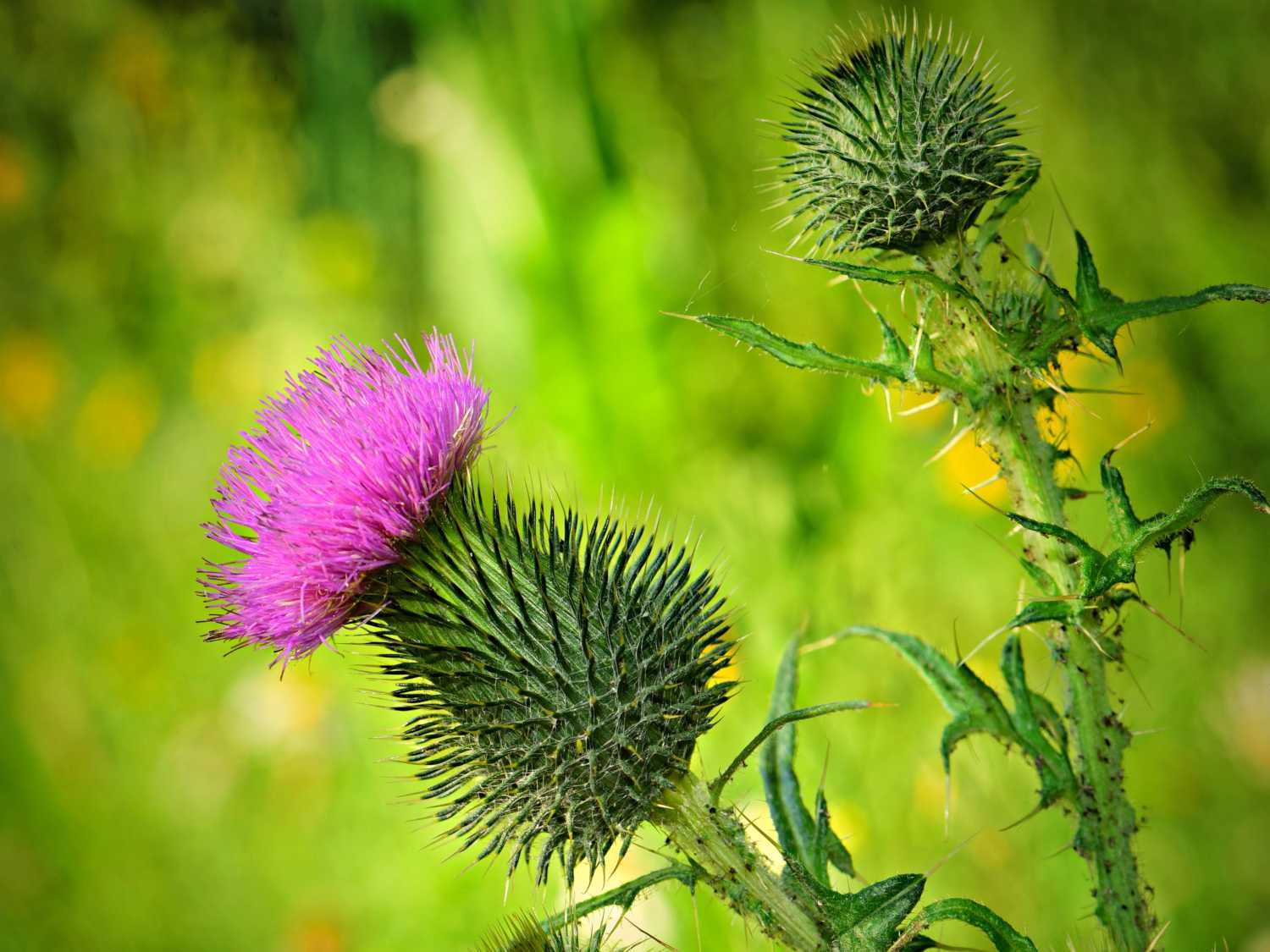
Thistles, with their prickly exteriors and vibrant purple flowers, are a fascinating group of plants that have intrigued botanists and garden enthusiasts for centuries. Despite their often unwanted reputation as stubborn weeds, thistles have a rich history and unique characteristics that make them more captivating than meets the eye. In this article, we will delve into 19 captivating facts about thistles, exploring their diverse species, medicinal properties, cultural significance, and ecological roles. Whether you’re curious about the different types of thistles, the symbolic meaning they hold, or their surprising benefits, this article will provide you with an in-depth understanding of these intriguing plants. So, let’s roll up our sleeves and uncover the secrets of thistles!
Key Takeaways:
- Thistle, a prickly plant with beautiful flowers, has over 200 species and historical significance. It attracts pollinators, provides food for wildlife, and has medicinal properties. It’s also a national emblem of Scotland.
- Thistle, a versatile plant, has cultural significance, medicinal properties, and is a source of natural fibers and dyes. It’s used in culinary preparations, as a protective fence, and in bird feeders.
Thistle is a prickly plant with beautiful flowers.
Thistle is a fascinating plant that is well-known for its prickly nature and beautiful flowerheads.
There are over 200 species of thistle.
Did you know that thistle comprises over 200 different species, each with its unique characteristics and appearances?
Thistle is a member of the aster family.
Belonging to the aster family (Asteraceae), thistle shares its lineage with other well-known plants such as daisies and sunflowers.
Thistle is native to Eurasia, Africa, and the Mediterranean region.
With its origins in Eurasia, Africa, and the Mediterranean region, thistle has spread to various parts of the world due to its adaptability.
Thistle has deep historical and cultural significance.
Throughout history, thistle has played a significant role in various cultures, symbolizing resilience, protection, and independence.
Thistle flowers attract pollinators.
The vibrant and nectar-filled flowers of thistle attract a wide range of pollinators, including bees, butterflies, and birds.
Thistle seeds are dispersed by the wind.
Once the thistle flowers have withered, they produce seedheads with fluffy tufts that allow the seeds to be carried by the wind for dispersal.
Thistle is a valuable source of food for wildlife.
Many animals, including birds and small mammals, rely on thistle seeds and leaves as a source of nutrition, especially during harsh winters.
Thistle has medicinal properties.
In traditional medicine, thistle has been used to treat various ailments, including liver disorders, digestive issues, and skin conditions.
Thistle is considered a noxious weed in certain regions.
In some parts of the world, thistle is classified as a noxious weed due to its ability to spread rapidly and compete with native plant species.
Thistle leaves are often used in culinary preparations.
The young, tender leaves of certain thistle species can be cooked or added to salads, providing a unique and slightly bitter flavor.
Thistle is the national emblem of Scotland.
The Scottish thistle, known as the “Scotch thistle,” is the national emblem of Scotland, representing strength, resilience, and defiance.
Thistle is a source of natural fibers.
The stalks of certain thistle species can be processed to extract strong and durable fibers, which are used in traditional crafts and textiles.
Thistle has been used as a natural dye.
The flowers of some thistle species, particularly those with vibrant purple hues, can be used to create natural dyes for fabrics and fibers.
Thistle plants can thrive in various environments.
Thistle is known for its adaptability and can be found in diverse habitats, ranging from dry grasslands to wet marshes and even disturbed areas.
Thistle has been used as a protective fence.
In some cultures, thistle plants have been woven together to create natural fences to deter animals and protect valuable crops.
Thistle is a popular floral symbol.
Thistle is often incorporated into floral arrangements and bouquets, adding a touch of uniqueness and texture to any composition.
Thistle has inspired various works of art.
Artists and craftspeople have frequently drawn upon thistle’s intriguing form and symbolism, capturing its essence in paintings, sculptures, and designs.
Thistle seeds are used in bird feeders.
The seeds of certain thistle species, such as the popular Nyjer seed, are commonly included in bird feeders to attract finches and other seed-eating birds.
Conclusion
Thistle is a captivating plant that has been a topic of intrigue for centuries. Its unique appearance, diverse species, and interesting characteristics make it a fascinating subject for plant enthusiasts. From its spiky leaves and vibrant blossoms to its medicinal properties and ecological importance, thistle is truly a remarkable plant.
Whether you appreciate its beauty in the wild or cultivate it in your garden, thistle offers a visual spectacle and a deeper appreciation for the natural world. The next time you encounter a thistle, take a moment to admire its resilience and hidden wonders. You might just discover a newfound admiration for this remarkable plant.
FAQs
Q: What is thistle?
A: Thistle is a term that refers to a group of flowering plants belonging to the family Asteraceae. They are known for their spiky leaves and distinctive blossoms.
Q: Are all thistles considered weeds?
A: Not all thistles are considered weeds. Some thistle species, like the globe thistle and the Scotch thistle, are cultivated for their ornamental value.
Q: Are thistles a beneficial plant?
A: Yes, thistles have several benefits. They provide nectar for pollinators, support biodiversity, and can be used for medicinal purposes as well.
Q: Can thistles be harmful to humans?
A: While some thistles have sharp spines that can cause minor injuries, most thistles are not harmful to humans. However, it is always advisable to handle plants with caution.
Q: Can I grow thistles in my garden?
A: Yes, you can cultivate certain thistle species in your garden. However, it’s important to check your local regulations, as some thistle species may be considered invasive in certain areas.
Q: What is the significance of thistles in folklore and symbolism?
A: Thistles have various symbolic meanings in different cultures. They are often associated with resilience, protection, and strength.
Q: Are there any edible thistles?
A: Yes, some thistle species, like the artichoke thistle and the milk thistle, have edible parts that can be consumed or used for culinary purposes.
Thistle's allure extends beyond its prickly exterior, with globe thistle boasting extraordinary qualities that beckon further exploration. Football enthusiasts might find themselves drawn to the intriguing facts surrounding Inverness Caledonian Thistle FC, a club steeped in history and triumphs. For those still captivated by thistle's charms, an additional 20 facts await, promising to deepen appreciation for this multifaceted plant. Whether you're a nature lover, sports fan, or simply curious about the world around you, these articles offer a wealth of knowledge and entertainment.
Was this page helpful?
Our commitment to delivering trustworthy and engaging content is at the heart of what we do. Each fact on our site is contributed by real users like you, bringing a wealth of diverse insights and information. To ensure the highest standards of accuracy and reliability, our dedicated editors meticulously review each submission. This process guarantees that the facts we share are not only fascinating but also credible. Trust in our commitment to quality and authenticity as you explore and learn with us.


